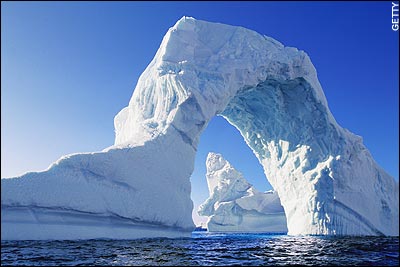 Man has been blamed for the first time for rising temperatures in the Antarctic.
Man has been blamed for the first time for rising temperatures in the Antarctic.Climate change accelerating far beyond the IPCC forecast, WWF says
Arctic air temperature at record high due to sea ice loss
Climate change 'tipping point' within 100 years
Scientists say they now have conclusive proof that warming is due to man's influence mainly through greenhouse gases and ozone depletion.
Ozone hole over Antarctica covered area size of North America
Higher temperatures and loss of ice could lead to a potentially disastrous rise in sea levels as well as threatening the survival of marine and land animals in the polar regions.
In 2007 the International Panel on Climate Change (IPCC) said the Antarctic was the only continent where man-made temperature change had not been seen but the latest study by an international team of scientists says this is no longer the case.
They looked at average temperatures recorded at 70 different stations in the Antarctic over the past 50 years and then compared them with four different climate models. In the Arctic they were able to look back over 100 years of average temperatures from 80 stations.
The results, published online in Nature Geoscience, reveal human influence is the cause of significant warming over both Polar regions since 2000.
The study says that although the findings are dramatic, particularly in the Arctic, they are consistent with climate modelling predictions.
Although the research, led by the University of East Anglia (UEA) is emphatic its likely to stoke the controversy over whether man is bring about changes in the world climate, as the IPCC report claims, or whether it part of the climate's natural cycle.
Dr Nathan Gillett, formerly of the UEA's Climatic Research Unit who now works for Environment Canada, said: "We compared the most up to date surface temperature observations with four state-of-the-art climate models and you cannot explain these changes away by natural processes.
"It is only when you factor in the human climate influence that you achieve these results. With the human influence the findings are consistent and predictable. Without them they are not."
And Dr Peter Stott, head of climate monitoring at the Met Office, which also took part in the study, said: "This is the first study of its kind looking at the best data available and it shows a significant human influence.
"In both Polar regions the observed warming can only be reproduced in our models by including human influences - natural forces alone are not enough.
"It is only when you factor in the human climate influence that you achieve these results.. With the human influence the findings are consistent and predictable. Without them they are not."
And Dr Peter Stott, head of climate monitoring at the Met Office, which also took part in the study, said: "This is the first study of its kind looking at the best data available and it shows a significant human influence.
"In both Polar regions the observed warming can only be reproduced in our models by including human influences - natural forces alone are not enough."
A lack of data and the variability of the climate has prevented studies in the past from attributing changes in both Arctic and Antarctic temperatures to the influence of man.
The new study updated all the historical land surface temperature observations in both regions and then looked at the simulations from different climate models to reach its conclusions.
It found that the average temperature in the Arctic has risen by 2ºC over the past 40 years - much higher than the global average - and by about 1ºC in the Antarctic which though less is still significant. There are some areas of the Antarctic that have not warmed and the temperature rise is taken from an average.
Dr Gillett said: "Greenhouses gases are the main driver of the change along with ozone depletion, chemicals, aerosols and particles of soot.
"We tried large simulations of natural climate change to see if we could obtain the same results but it couldn't be done. It is only when you add man's affect that you get the changes we are now seeing.
"There are bound to be consequences - it could lead to sea level rises, melting of the ice sheets and collapses of ice on the Antarctic Peninsula.
"In the Arctic it is already associated with an increased glacier flows and increasing sea levels."
